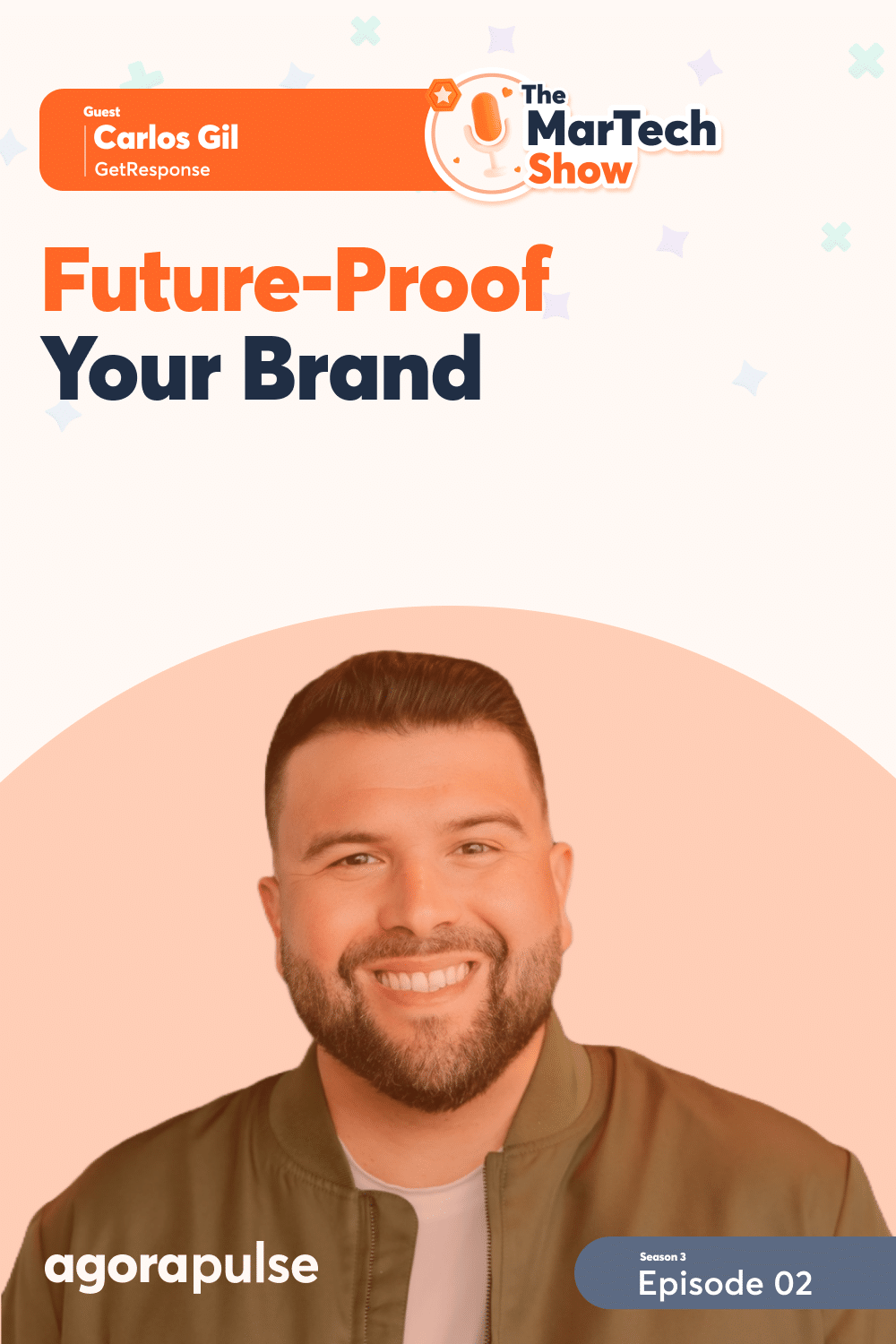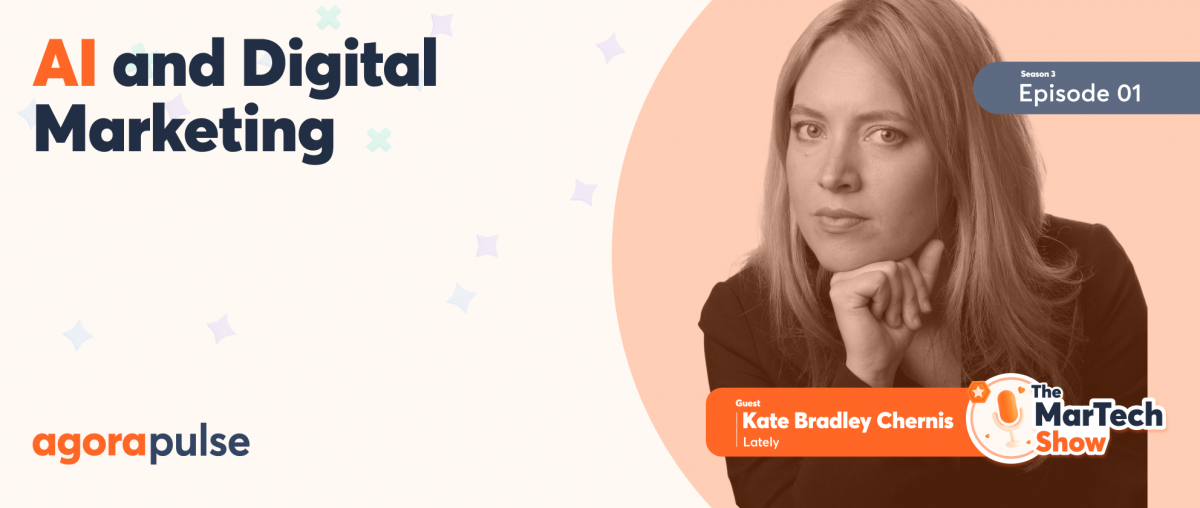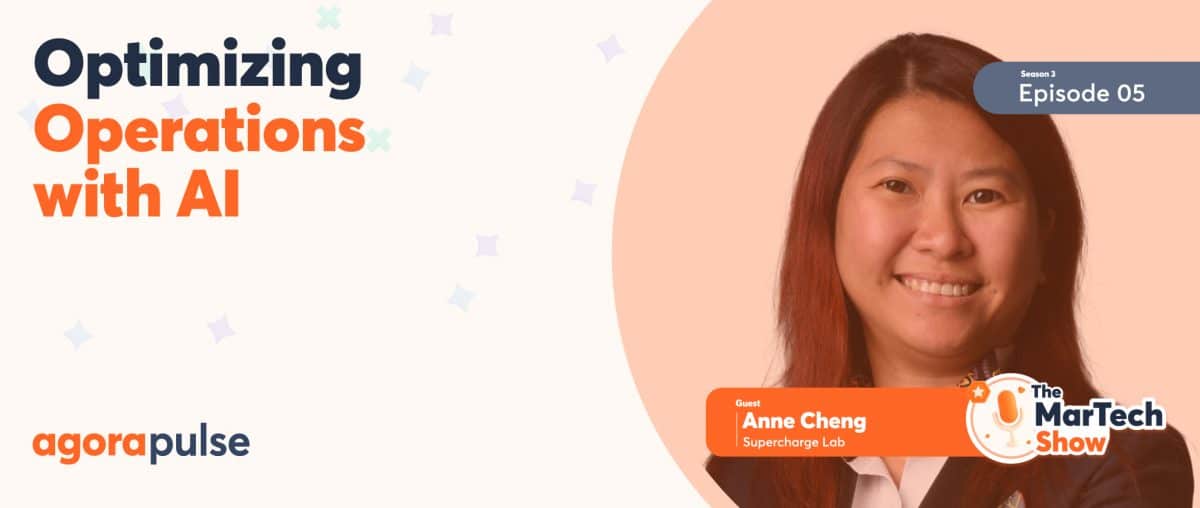What if you could ensure your brand stays relevant and robust, no matter how the digital landscape changes? Many brands rely heavily on a single channel, like social media, making them a little vulnerable to sudden changes and platform-specific issues. When platforms change algorithms or face restrictions, brands that aren’t diversified can see their reach and engagement more clearly. This leaves marketers scrambling to regain lost ground, often with limited success. Want to know how to address that?
That’s what we’re covering in this recap of episode 2 of The MarTech Show, hosted by Agorapulse chief storyteller, Mike Allton.
[Listen to the full episode below, or read on for transcript highlights. And sign up now for a free trial of Agorapulse today.]
How Brands Should Future-Proof and Diversify
Here, we’ve got an example of how the social media and marketing landscape can change with platforms that may have once been key to a business’s traffic conversion success suddenly changing and evaporating all that success seemingly overnight. I mean, X is hardly the first platform to struggle and harm businesses. Google Plus, Blab, Periscope, and Vine—those are just a few examples of platforms that were shut down after users and businesses spent years building followings and referral traffic, while even mainstays like Facebook and LinkedIn continue to see a decline in brand reach and engagement.
How are brands supposed to utilize social media without becoming dependent on any one platform?
That’s what Carlos Gil is here to help us with. Carlos is a marketing expert with over 15 years of experience, specializing in driving ROI through growth, marketing, social media strategy, and content creation. Currently, he’s the brand evangelist for GetResponse. Carlos is also a sought-after public speaker, author, and consultant. He’s known for his innovative approaches to integrating social media and email marketing to build strong, future-proof brands. Carlos shares his expertise through speaking engagements at major industry events like South by Southwest and Social Media Marketing World. His work has been featured in notable publications, such as CNN Money, Inc. Magazine, and Social Media Examiner.
Carlos Gil: I just went through a trip down memory lane. They’re hearing about Blab, Periscope, Meerkat, and Vine. And that’s a good segue in terms of why I’m here to talk to all of you about email marketing.
Mike Allton: That is exactly what I’d love you to do. So start by telling us more about your role at GetResponse and some of the unique solutions that GetResponse offers.
Carlos Gil: First of all, I want to say I’m excited about doing this MarTech show with you, Mike and Robin. Agorapulse is a platform that I’ve not only long admired, but I’ve also advocated for very publicly through my talks, courses, and my book, The End of Marketing. So when I took this role many months ago, I thought about you, Mike, in your role with Agorapulse because I’ve seen firsthand—as someone who’s worked in social media marketing on the front lines for the last decade, I’ve seen the great work that you’ve done in terms of elevating Agorapulse throughout our industry. So kudos to you, sir.
Starting at GetResponse
- I was introduced to GetResponse by a gentleman who, ironically, used to work for them many years ago, but I met him when he was working for another company, Brand24, which—I’ll connect the dots. (I think you can appreciate this, Mike. Brand24 sponsored at Social Media Marketing World many moons ago, pre-COVID. They featured me, you, and several of our friends and their annual Influencer Marketing Report, featuring social media marketing thought leaders like the top 100 most influential social media marketing thought leaders.)
- So I learned about Brand24. Mick Griffin, who previously worked at GetResponse, worked also for Brand24, so that’s how he learned about me. And he hits me up one day, and he’s like, “Hey, you might want to take a look at this company. They’re based here in Poland. They’re an email marketing company, but they’re looking for someone to help them drive awareness in the US.”
- And I was hesitant at first for a couple of reasons. 1. I wasn’t necessarily familiar with the company. And that has nothing else to do with the fact that coming from the social media marketing side of the digital track. I was familiar with the more like well-known enterprise Salesforce HubSpot-like platforms, but in terms of GetResponse, they weren’t necessarily on my radar at that point. But then also 2. Just having some hesitancy—would I be able to make an impact for this company working across the miles?
- To be candid with you, once I had that first initial job interview and went through the different rounds of job interviews, I realized very quickly that if there’s any company where I could potentially make a difference, it’s this one. If I was to go work for a Fortune 500 company as a head of social, for example, are they going to give me the autonomy to do what we’re doing here today to provide thought leadership for the industry? Are they going to support me speaking? These are areas of my career that are very important.
The role was—and very much still is—centered around helping GetResponse known in the U.S. through forming strategic partnerships and alliances with different platforms, such as Agorapulse.
GetResponse is one of the oldest—I like to call them an OG—but they’re one of the oldest email marketing platforms in the entire industry. They’ve been around for over 25 years. As I mentioned before, it’s a company that’s based in Poland. They were founded in Poland by our CEO and founder Simon in his parent’s basement. It’s just a remarkable, remarkable story. And we have a massive customer base of over 400,000 customers around the world doing a lot of cool things, such as rolling out an entire content monetization platform and tapping into the creator economy. So there are so many good things that this company has going for it.
Vanity Metrics
As the pendulum has swung the other way—going back again to the examples of the Vines, Labs, Meerkats, and the declining reach on these social platforms—I realize as A. a marketer and B. as a business owner as well that owning your data in almost 2025 is more important than your social media followers or social media vanity metrics. We can hit this point on the head until we’re all blue in the face.
“Social media vanity metrics look good on the surface. But ultimately, if those followers and those vanity metrics aren’t converting to real business, then what good is it to have a check mark on Instagram or have 100,000 followers?
I would any day rather have a thousand engaged email subscribers where I can now measure the effectiveness of my marketing through opens, clicks, and conversions.”
That’s a very long way of saying that I dove headfirst into the email marketing space. Creating content like this in collaboration with a platform can be one of my core focuses going forward and helping social of all kinds realize that social media for—as much as we love it, yes, you still should be using these mediums—from a brand building standpoint, from a business awareness standpoint, engaging with your customers, customer service, etc. There’s value there. There’s marginal value there in terms of rolling the dice and your entire digital marketing strategy revolving around social media and ignoring email like that in itself is a recipe for disaster.
So there’s, again, one thing I can just echo—and I know we’re going to talk about this over and over—is brands today need to be focusing on how they’re going to future-proof their brand over the next decade.
AI is disrupting just about everything that we’ve learned to this point about marketing. You can move faster. You can move more efficiently. AI is also fragmenting the relationship between the consumer or the follower in this case and the brand, whereas email still gives you that direct one-to-one connection. I’m a few months into this gig and just excited about what the future holds for GetResponse.
Mike Allton: Well, I appreciate the shout-out. And I concur. We’ve partnered with GetResponse a few times at Agorapulse and we love it.
Robin Dimond: I mean, I feel like, Carlos, you just like literally gave us so many truth bombs throughout this whole thing. Each phrase that you said, I want to help unpack.
There is so much depth, and I love that you talked about that.
Why should brands diversify and not rely solely on social media?
Carlos Gil: No, agreed. I am with you 110%. And the conversation that we should be having again, and what one of my goals coming into GetResponse has been and will continue to be.
And I just want to pause right there and say: This is going to be the first, I predict (bold prediction here, guys) this is going to be the first of many collaborations that we do with GetResponse and Agorapulse, because these conversations, they need to be had over and over again. The conversation that needs to be had is around: How do you marry social and email marketing together? How do you convert a social media follower into an email subscriber? What does that funnel look like?
I know we’re gonna talk about this today, but the conversation shouldn’t end today. It should be one that continues.
(Over the last 10 years, I’ve worked for big corporations. I’ve worked as a head of social media as a team of one. I’ve worked as a head of social media leading a global team. One thing is paramount, though, and in these companies that I’ve worked for, I’ve also advised and consulted for numerous, numerous Fortune 500s on social media marketing.)
One thing I’ve witnessed firsthand is your social media team usually is not working directly with the people who are behind the scenes pushing the buttons for your email marketing campaigns. The digital marketing team is not necessarily in the weeds with the social media team. There’s some overlap around campaigns, in terms of people coming to the table. They’re presenting, “Hey, this is what we’re doing to support this initiative or this outreach.”
But in terms of having a symbiotic relationship—which is what you’re talking about—a true omnichannel strategy, you need to have the team or the person and organization that’s behind the controls of your social media engaging and working directly with people/person who’s responsible for email marketing. Those two teams need to be working together in tandem on developing a strategy in which the email flows into social and social content flows right back into the email.
Mike Allton: You’re right that most businesses are completely different teams. They may not even talk to each other. Maybe they’ll see each other once in a while at a monthly meeting or something like that, but they’re not.
Teamwork and Synergy Between Social and Email
Take us through in a little more detail, please, how those teams would work together. I mean, it’s one thing to just say, okay, we’re all going to work on this campaign, but how does that synergy happen between email and social media? Can you walk us through that?
Carlos Gil: One hundred percent. So that’s a good point. I would say that it goes back to what the objectives of each platform are.
Let’s start with social. Social should not be used as a medium to sell. Social should be used as a medium for one of three things.
Social should be used as a medium to:
- educate
- inspire
- entertain
And leave it at that. If you look at the content that performs well on social media, it falls into one of those three categories.
I like to use this analogy of online dating today and Tinder, right? This is the Tinder approach to marketing. This is where it gets a little weird. So let me explain this, right?
In the world of online dating, what are people reacting to? They’re reacting to content being another person that they perceive is looking good. And within a split second, you’re deciding. All right, this person I find attractive and appealing—I want to get to know them, so I’m going to swipe one way. The person that doesn’t seem as appealing—I’m going to swipe the other way.
Content marketing on social media operates in the very, very same vein as online dating today. The difference is you’re on a phone, you’re swiping fast up and down content that you perceive as being an ad from a brand or being sales-y in nature, and you’re going to keep swiping right on content that has high engagement in.
This is where the vanity metrics do matter, but content that is high engagement content is perceived as bringing some sort of value. Whether you can learn something, you can learn a hack, DIY, whatever it might be—there’s educational content, there’s something that inspires you. Or entertainment, right? I’m a sports fanatic, right? So, you know, content related to sports, or movies, or pop culture. Like, those three categories, if you pay attention, that’s the type of content that people are gravitating to social media for. Spoiler alert for all the marketers in the room watching [or reading!] this.
No one’s going to social media with the intent of seeing your content.
Quote me on that until the cows come home. Not a single person that follows your brand is going with intention on Instagram when they wake up first thing in the morning to see what your brand posts. I don’t care who you are. I don’t care if you’re the biggest brand in the world. People aren’t doing that.
They’re going on social media to escape. They’re going on social media to learn something, to be inspired, and, again, to be entertained. So knowing that the job of a marketer who’s using these mediums should be to drive as much engagement around those three principles: Educate, inspire, entertain, drive as much engagement to then get more people into your ecosystem. Because the name of the game here is to get people to share your content. By sharing that content, it elevates your brand awareness for free without having to pay for more people to know that you exist. And now as more people are coming into your ecosystem to keep them engaged—and this is key—you should be using a medium like Stories.
You use Instagram Stories to keep the conversation going, right? You’re keeping that community engaged. You’re posting content in real-time. You’re showing what makes your brand human. You’re connecting a face, a voice with your brand, instead of posting content that’s static and seems like an ad. And you’re doing this for no other reason than that is what works. That is what the influencers, the creators, the everyday mom, the everyday dad, everyday working professional—that’s what they’re doing. If they’re doing that, then you as a brand should be doing the same thing.
That’s more or less my synopsis at a very high level. Whether it’s Instagram or it’s TikTok LinkedIn, this is the same playbook that’s interchangeable. And then, yes, each medium has a tool set or two that you can tinker with. That’s the key. You don’t use mediums to sell because people don’t want to be sold to. They want to be engaged.
The flip side to that is where email comes in. So email, I would say is when you kind of have to stack rank the importance of these mediums. Email is significantly more important than social media to sell. Email is actually where you can sell, but how you sell—there’s finesse to it. Again, knowing that when people open up their phone, and they go to their Gmail or Outlook or whatever medium they use to receive an email, the first thing that they see from your brand is an advertisement. More than likely, they’re going to delete it. They’re probably not going to unsubscribe, but they’re going to delete it, and you don’t want that.
You don’t want someone to delete because that’s the equivalent of someone continuing to scroll on Instagram or TikTok and not seeing your content, right? So, you need to find ways to make your content sound human, engaging, relevant, and guess what? Plug for GetResponse here. GetResponse has an AI builder that will help you optimize your subject lines to ensure that they don’t sound sales-y, and they sound engaging in nature. And we can get into that as we go along here, but I’m just walking you guys through the relationship between email and social.
Email is where you should use your email newsletter as a bulletin, so to speak, of what’s happening within your organization, company news announcements, someone within your organization did something awesome in the community, spotlight that in your email, but then also incorporate into the email the sale or the pitch or the offer of where you want people to go and also connect relevant social media content. So if you had an educational post, and that got a lot of engagement, drop that in your email newsletter, right? So if you do this over time, you’re training your audience, which is the same.
Brands that Integrate Email with Social Media (Successfully)
Mike Allton: Wondering if you could share some examples of some brands, whether they’re using GetResponse or something else, but we’re looking for brands that have done what you’re talking about. They’ve successfully integrated email and social media and what that looked like.
Do you have any examples that come to mind?
Carlos Gil: There’s one that comes to mind I’m a big fan of. I follow the brands that I shop with or support financially very closely. Because again, as a marketer, I want to be able to show love.
Nordstrom is a brand that I think does a really good job of doing both email and social. Their social content strikes a chord with me because they put a lot of human faces. They partner with influencers and creators in the fashion space, but then their email campaigns are very much tailored to sales-driven content. And one thing I don’t want to get lost here is it’s okay to sell. Your customers realize it; you’re in business. Your job as a marketer is to provide them with solutions. However, it’s not always about the sale and every meeting. So, I would say again, that Nordstrom is a brand that I like their approach to marketing.
I’m a big fan of Wendy’s persona on social because I think they do a really good job of humanizing their brand by having trollish or wrestling fans out there. I’m going to use the term. They have a heelish type tone to their persona online, but they also don’t have a face, like that’s the difference.
For your brand to stand out in this AI-driven economy that we’re in that is creating more noise and more content, you need to put a human face behind your brand or in front of your brand. Wendy’s has found a good balance to still promote their brand and get engagement but also sound different than every other cookie-cutter agency or marketer that’s behind these big brands.
Best Practices for Caring for Your Email List
Robin Dimond: I think if you could share without giving all your secrets away, what’s your experience with it? Best practices for building and nurturing that email list once you get them.
Carlos Gil: That’s a good question.
Segmentation is key. So if you are dumping people into your email newsletter, so, for example, you go on Zapier, Right? There’s integration where if you use, for example, a competitor, let’s just say MailChimp, you can connect your MailChimp with your GetResponse account through Zapier. You can import your connections over into GetResponse. And, you know, not to make this product pitch by any means, guys, but GetResponse allows you to join and use GetResponse for free for 30 days. So if you’re watching this right now, I encourage you to go to getresponse.com, and sign up for the free trial.
One of the first things I want you to do is go to Zapier, Zapier, and then whoever you’re using, whether it’s MailChimp or Constant Contact or whomever, connect through Zapier. So you can easily import your connections over into GetResponse. But what you really need to focus on is the segmentation aspect of this. You don’t want, even if you have, let’s just say hypothetically 20, 000 contacts in your email list, you don’t want to always be sending the same email to those 20, 000 contacts. Instead what you want to do is you want to tailor your content.
So, In my own GetResponse account, I have a list which is called Open Engagers Insider Circle. So I used to use another platform before coming over to GetResponse. And I had my campaign segmented out based on whoever opened up an email within the last five sends was on this list. Okay, so I was constantly going in scrubbing this list because I want to ensure to have the highest open rate, highest click-through rate, and highest conversion rate.
I want to ensure that my emails are going to the people who really want to see those emails because the relationship is going to be different with them. If I have 20, 00 contacts, but yet only a thousand of them are my most engaged, I can have a very different relationship in how I speak to those contacts. I can give them something for free. I can say, “Hey, look, like I’m going to do a zoom for a hundred people. I want you to jump on and any questions that you have, let’s just do, you know, a coffee side chat virtually. “Like I can do that with a very limited number of people. The people that don’t necessarily engage open, click convert. That’s a different segment altogether because that’s a different relationship. And I feel like that’s the segment going back to where marketers mess up. They’re focusing constantly on the most engaged. We’re the followers that are the most loyal to the brand and they lose sight of those that aren’t as engaged.
And that is where the magic really happens. And that’s key is getting more people from the big bucket of the let’s just call them uninterested yet opted-in crew over into the engaged Insider Crew and you do that through segmentation. So I would say again, going back to answer your question, one of the first things that you should do when optimizing your email, you know, hopefully, it’s GetResponse. But when you, you know, use any of these platforms and you’re optimizing your contacts, segment them out.
The second is setting up autoresponders. So you should go through and think of setting up autoresponders is almost like setting up smart devices in your home for them to all kind of be synchronized and work together and use it. And, I’m actually doing a webinar next Wednesday, right around this time at noon Eastern on marketing automation.
So if you go to getresponse. com, go to our webinar section, and sign up for it. I’m going to go much more in-depth with this. But with that being said, auto responders are key because what you want to do is again, to build this relationship with your customer, you kind of want to be always on. So if someone opts in, they’re receiving an email from you and that email is going to give them instructions on what to do next. Or that email could be a drip campaign that you set up where today, upon opt-in, they’re receiving X. Tomorrow within 24 hours, they’re going to receive something else. It could be a video, it could be an offer. 72 hours after that, they’re going to receive something else. But my whole point in saying this is when you set up autoresponders, you have an always-on relationship with customers. And the same thing happens when you send out a campaign. People that open, or people that click, or people that don’t open, don’t click, or don’t take any action. You can set up autoresponders to ensure that you’re not just hitting the button once and waiting to see what happens, but instead, you have a full marketing campaign with multiple different touch points.
Mike Allton: I think that’s amazing. The segmentation point was really powerful because there’s such a difference between email and social media in that regard. On email, you know exactly who hasn’t opened your emails or clicked through on any of your links for a while.
On social media, we don’t know. We know who we haven’t seen, maybe if we’re paying attention, but we’ve got no way to talk to them directly to the people who haven’t engaged with our page or profile on social media. So I appreciate that you called out that difference and made sure that the marketers know that they’re potentially missing an opportunity with email that doesn’t exist on other channels.
How YOU Can Get Connected to GetResponse
Carlos, this has been such an interesting interview. Thank you so much. For folks who want to know more about you or know more about GetResponse, where can they go to find you and reach out?
Carlos Gil: First of all, thanks so much to you guys. Thank you to Agorapulse, Mike, Robin. This has been great. I hope we get a chance to do this again.
If you want to learn anything about GetResponse, hit me up directly. I’m easily accessible on all the socials @CarlosGill83 on X as well as Instagram. You can also hit me up on LinkedIn and again getresponse.com. Go there, and sign up for 30-day trial. Use the platform. I would love to hear your feedback.
“Feedback is a gift.” I say this all the time in the public speaking world. So whatever you think about the platform, I want to hear about it. I want to share it with our executives, and it’s at GetResponse on X, as well as on IG. So once again, guys, hopefully, this has brought some value to your listeners out there. And I look forward to doing this again with you guys.
If you want to make sure you’re part of our audience during live weekly broadcasts, take a look at our calendar at agorapulse.com/calendar, or click the subscribe button in your email. Once you register for any of these events, is there a particular tool or topic you’d like to see us talk about? Or perhaps you think your solution should be featured? Email mike@agorapulse.com.






